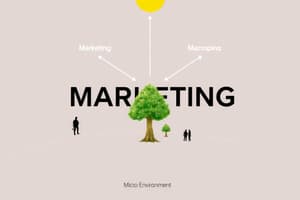Podcast
Questions and Answers
The microenvironment consists of the actors close to the company.
The microenvironment consists of the actors close to the company.
True (A)
The macroenvironment only includes the company's internal factors.
The macroenvironment only includes the company's internal factors.
False (B)
Demographic forces are part of the macroenvironment.
Demographic forces are part of the macroenvironment.
True (A)
The marketing environment includes only economic forces.
The marketing environment includes only economic forces.
Technological forces can impact a company's marketing decisions.
Technological forces can impact a company's marketing decisions.
Political forces do not affect the marketing environment.
Political forces do not affect the marketing environment.
Customers are part of the microenvironment.
Customers are part of the microenvironment.
Cultural forces are irrelevant to marketing management.
Cultural forces are irrelevant to marketing management.
Suppliers provide the resources to produce goods and services.
Suppliers provide the resources to produce goods and services.
Marketing intermediaries only involve financial services.
Marketing intermediaries only involve financial services.
Firms should position their offerings against competitors’ offerings.
Firms should position their offerings against competitors’ offerings.
The general public is not considered a public that impacts an organization's goals.
The general public is not considered a public that impacts an organization's goals.
Marketing plans do not consider the different groups within a company.
Marketing plans do not consider the different groups within a company.
Coca-Cola provides powerful marketing support to its retail partners.
Coca-Cola provides powerful marketing support to its retail partners.
There are no international markets considered in marketing.
There are no international markets considered in marketing.
Internal publics include employees of an organization.
Internal publics include employees of an organization.
The economic environment impacts consumer purchasing power and spending patterns.
The economic environment impacts consumer purchasing power and spending patterns.
Value marketing focuses on offering lower quality at a higher price.
Value marketing focuses on offering lower quality at a higher price.
The natural environment refers to technological advancements in marketing.
The natural environment refers to technological advancements in marketing.
Demographic and economic changes can influence marketing decisions.
Demographic and economic changes can influence marketing decisions.
Over time, the middle class has remained stable in size.
Over time, the middle class has remained stable in size.
Telecommuting has changed where people work.
Telecommuting has changed where people work.
Developing economies do not present marketing opportunities.
Developing economies do not present marketing opportunities.
The rich have decreased their wealth over recent decades.
The rich have decreased their wealth over recent decades.
Environmental sustainability aims to create a world economy that the planet can support indefinitely.
Environmental sustainability aims to create a world economy that the planet can support indefinitely.
Increased pollution is not a trend in the natural environment.
Increased pollution is not a trend in the natural environment.
The technological environment is considered the most dramatic force in changing the marketplace.
The technological environment is considered the most dramatic force in changing the marketplace.
Legislation regulating business aims to primarily benefit consumer interests.
Legislation regulating business aims to primarily benefit consumer interests.
The cultural environment is defined solely by economic factors.
The cultural environment is defined solely by economic factors.
Cause-related marketing is an aspect of increased emphasis on ethics in business.
Cause-related marketing is an aspect of increased emphasis on ethics in business.
Developing strategies that support environmental sustainability is irrelevant to businesses today.
Developing strategies that support environmental sustainability is irrelevant to businesses today.
Increased government intervention is not a trend impacting the natural environment.
Increased government intervention is not a trend impacting the natural environment.
Core beliefs and values are easily changed over time.
Core beliefs and values are easily changed over time.
Secondary beliefs and values are more open to change compared to core beliefs.
Secondary beliefs and values are more open to change compared to core beliefs.
Companies have no control over the marketing environment.
Companies have no control over the marketing environment.
Proactive companies take aggressive actions to influence their marketing environment.
Proactive companies take aggressive actions to influence their marketing environment.
Reacting to the environment means taking no actions at all.
Reacting to the environment means taking no actions at all.
Cultural values can influence people's views of nature and the universe.
Cultural values can influence people's views of nature and the universe.
The political environment has little effect on the marketing environment.
The political environment has little effect on the marketing environment.
Businesses can only adopt a reactive approach towards marketing challenges.
Businesses can only adopt a reactive approach towards marketing challenges.
Customer insights are based on fresh marketing information and provide understandings of customers and the marketplace.
Customer insights are based on fresh marketing information and provide understandings of customers and the marketplace.
Obtainable customer needs and buying motives are always obvious and easily communicated by customers.
Obtainable customer needs and buying motives are always obvious and easily communicated by customers.
Better information and effective use of existing information can enhance customer insights.
Better information and effective use of existing information can enhance customer insights.
Marketing information systems consist solely of data collection.
Marketing information systems consist solely of data collection.
Companies do not face any special issues in marketing research related to public policy.
Companies do not face any special issues in marketing research related to public policy.
Gaining insights about the marketplace and customers is unimportant for effective marketing.
Gaining insights about the marketplace and customers is unimportant for effective marketing.
The steps in the marketing research process are crucial for understanding customers and their needs.
The steps in the marketing research process are crucial for understanding customers and their needs.
It is easy to obtain fresh insights into customer needs and wants.
It is easy to obtain fresh insights into customer needs and wants.
Internal data is collected from sources outside the company network.
Internal data is collected from sources outside the company network.
Competitive marketing intelligence involves the systematic collection of publicly available information.
Competitive marketing intelligence involves the systematic collection of publicly available information.
Marketing research is defined as the random collection of data.
Marketing research is defined as the random collection of data.
Exploratory research is one of the steps in the marketing research process.
Exploratory research is one of the steps in the marketing research process.
The marketing information system includes only competitive marketing intelligence.
The marketing information system includes only competitive marketing intelligence.
Developing a research plan outlines the sources of existing data and research approaches.
Developing a research plan outlines the sources of existing data and research approaches.
Marketing research does not require clear research objectives.
Marketing research does not require clear research objectives.
The marketing research process includes steps such as causal research.
The marketing research process includes steps such as causal research.
Secondary data is information collected for the specific purpose at hand.
Secondary data is information collected for the specific purpose at hand.
Ethnographic research involves sending trained observers to watch and interact with consumers in their natural environments.
Ethnographic research involves sending trained observers to watch and interact with consumers in their natural environments.
Observational research involves gathering primary data by asking people questions.
Observational research involves gathering primary data by asking people questions.
Survey research involves gathering primary data by observing relevant people and situations.
Survey research involves gathering primary data by observing relevant people and situations.
Primary data is information that already exists and was collected for another purpose.
Primary data is information that already exists and was collected for another purpose.
Experimental research collects primary data by selecting matched groups of subjects and giving them different treatments.
Experimental research collects primary data by selecting matched groups of subjects and giving them different treatments.
Gathering secondary data is typically more expensive than collecting primary data.
Gathering secondary data is typically more expensive than collecting primary data.
The budget is a component to consider when developing a research plan.
The budget is a component to consider when developing a research plan.
Mail contact method has excellent flexibility.
Mail contact method has excellent flexibility.
Online contact methods generally yield higher response rates.
Online contact methods generally yield higher response rates.
Personal contact methods allow for a greater quantity of data collection than telephone methods.
Personal contact methods allow for a greater quantity of data collection than telephone methods.
Focus groups are inexpensive and easy to generalize from.
Focus groups are inexpensive and easy to generalize from.
Probability sampling ensures every member of the population has an equal chance of selection.
Probability sampling ensures every member of the population has an equal chance of selection.
The speed of data collection is excellent for telephone methods.
The speed of data collection is excellent for telephone methods.
Control of interviewer effects is excellent with online contact methods.
Control of interviewer effects is excellent with online contact methods.
Sampling plans are essential for selecting a representative segment of the population for marketing research.
Sampling plans are essential for selecting a representative segment of the population for marketing research.
A cluster sample involves the population being divided into mutually exclusive groups.
A cluster sample involves the population being divided into mutually exclusive groups.
A convenience sample is randomly selected from the entire population.
A convenience sample is randomly selected from the entire population.
Primary data collection can be conducted through questionnaires, interviews, and observations.
Primary data collection can be conducted through questionnaires, interviews, and observations.
Mechanical research instruments are not used in marketing research.
Mechanical research instruments are not used in marketing research.
Analyzing information is one of the steps in implementing the research plan.
Analyzing information is one of the steps in implementing the research plan.
Interpreting findings is not a part of the marketing research process.
Interpreting findings is not a part of the marketing research process.
The main purpose of using judgment samples is to ensure randomized selection.
The main purpose of using judgment samples is to ensure randomized selection.
The first step in the marketing research process is defining the problem and research objectives.
The first step in the marketing research process is defining the problem and research objectives.
Flashcards are hidden until you start studying
Study Notes
Marketing Environment
- The marketing environment is composed of actors and forces outside marketing that affect a company's ability to build and maintain successful relationships with target customers.
Microenvironment
- The microenvironment includes actors close to the company that affect its ability to serve customers. They are the company, suppliers, marketing intermediaries, customer markets, competitors, and publics.
Macroenvironment
- The macroenvironment consists of larger societal forces that affect the microenvironment. These forces include:
- Demographic: Population characteristics such as age, gender, race, ethnicity, income, education, occupation, and family size.
- Economic: Factors that affect consumer purchasing power and spending patterns.
- Natural: Includes natural resources that are needed as inputs by marketers or are affected by their activities, such as shortages, pollution, and government intervention.
- Technological: Most dramatic force changing the marketplace by bringing new products, opportunities, and safety concerns.
- Political: Legislation regulating business to protect companies, consumers, and interests of society from unfair business practices.
- Cultural: Societal forces that affect a society's basic values, perceptions, and behaviors.
Responding to the Marketing Environment
- Companies can either be proactive or reactive. Proactive companies take aggressive actions to shape and affect forces in the environment, while reactive companies watch and react.
Marketing Information & Customer Insights
- Customer insights are fresh marketing information providing understanding of the marketplace and customers.
- These actionable insights are the basis for marketing decisions.
- Fresh and deep insights into customer needs and wants are important but difficult to obtain.
- Customer needs and buying motives are not always obvious.
- Customers themselves often struggle to articulate what they need or why.
Developing Marketing Information
- Marketers obtain information from three main sources:
- Internal Data: collected from the company's network
- Marketing Intelligence: public information about consumers, competitors, and market trends
- Marketing Research: data collected specifically for a marketing problem
Internal Data
- Internal databases are collections of consumer and market information gathered from within the company.
Competitive Marketing Intelligence
- Involves the systematic collection and analysis of publicly available information about consumers, competitors, and the marketing environment.
Marketing Research
- Marketing research is the systematic design, collection, analysis, and reporting of data relevant to a specific marketing situation.
- Marketing research is a crucial tool for understanding customer behavior, evaluating marketing strategies, and making informed decisions.
Steps in the Marketing Research Process
- 1. Defining the Problem and Research Objectives:
- Defining the specific marketing problem the research will address
- Clearly stating the research objectives (exploratory, descriptive, or causal)
- 2. Developing the Research Plan:
- Identifying data sources (secondary and primary data)
- Specifying research approaches (observational, survey, experimental)
- Outlining contact methods (mail, telephone, personal, online)
- Defining sampling plans (probability or non-probability)
- Selecting research instruments (questionnaires, mechanical devices)
- 3. Implementing the Research Plan:
- Collecting data
- Processing and cleaning data
- Analyzing data
- 4. Interpreting and Reporting Findings:
- Interpreting findings
- Drawing conclusions
- Reporting results to management
Primary Data Collection
- Types of Research Approaches:
- Observational research: involves observing relevant people, actions, and situations.
- Ethnographic research: trained observers watch and interact with consumers in their natural environment.
- Survey research: involves gathering data by asking people questions about their knowledge, attitudes, preferences, and behavior.
- Experimental research: uses matched groups of subjects, different treatments, controlled factors, and analyzes the differences in outcomes.
Primary Data Collection: Contact Methods
- Choosing the right contact method depends on the study's objectives, budget, and time constraints.
- Mail:
- Pros: cost-effective, can reach geographically dispersed audiences.
- Cons: low response rates, limited control over the environment.
- Telephone:
- Pros: faster data collection, higher response rates, allows for probing questions.
- Cons: decreasing response rates, difficulty reaching certain demographics
- Personal:
- Pros: versatility, control of interviewer effects, ability to observe non-verbal cues.
- Cons: high cost, time-consuming, potential for interviewer bias.
- Online:
- Pros: low cost, speed, high response rates, good for hard to reach groups.
- Cons: potential for bias, reaching specific demographics, access issues.
Primary Data Collection: Sampling Plan
- Sampling plan: a segment of the population selected to represent the population as a whole.
- Key Considerations:
- Who to study? (target population)
- How many people? (sample size)
- How to choose them? (sampling method)
Sample Types
- Probability Samples:
- Simple Random Sample: every member has an equal chance of selection.
- Stratified Random Sample: the population is divided into groups, and random samples are drawn from each group.
- Cluster (Area) Sample: the population is divided into groups, and a sample of groups is selected.
- Nonprobability Samples:
- Convenience Sample: the researcher selects the easiest population members.
- Judgment Sample: the researcher uses their judgment to select population members.
- Quota Sample: the researcher finds a prescribed number of people in each category.
Primary Data Collection: Research Instruments
- Questionnaires are the most common research instrument.
- Types:
- Closed-ended: predefined response options (e.g., multiple choice, scales).
- Open-ended: allow respondents to answer in their own words (e.g., short answer, essays).
Mechanical Research Instruments
-
Neuro-marketing: uses brain scanning technologies to measure consumer responses to stimuli.
-
Checkout scanners: capture purchase data.
-
People meters: measure TV viewing habits.
-
Mechanical devices: used for specific research purposes (e.g., eye tracking, gesture recognition).
Analyzing and Using Marketing Information
-
Companies analyze data to gain actionable insights.
-
Data analysis techniques include:
- Statistical analysis to identify trends and patterns.
- Data visualization to communicate results effectively.
- Data mining to discover hidden relationships in data.
Special Issues in Marketing Research
-
Public policy and ethics considerations:
- Privacy concerns: respecting consumer privacy and data security.
- Transparency and honesty: avoiding misleading information.
- Fairness and objectivity: conducting research in a fair and unbiased manner.
Studying That Suits You
Use AI to generate personalized quizzes and flashcards to suit your learning preferences.




